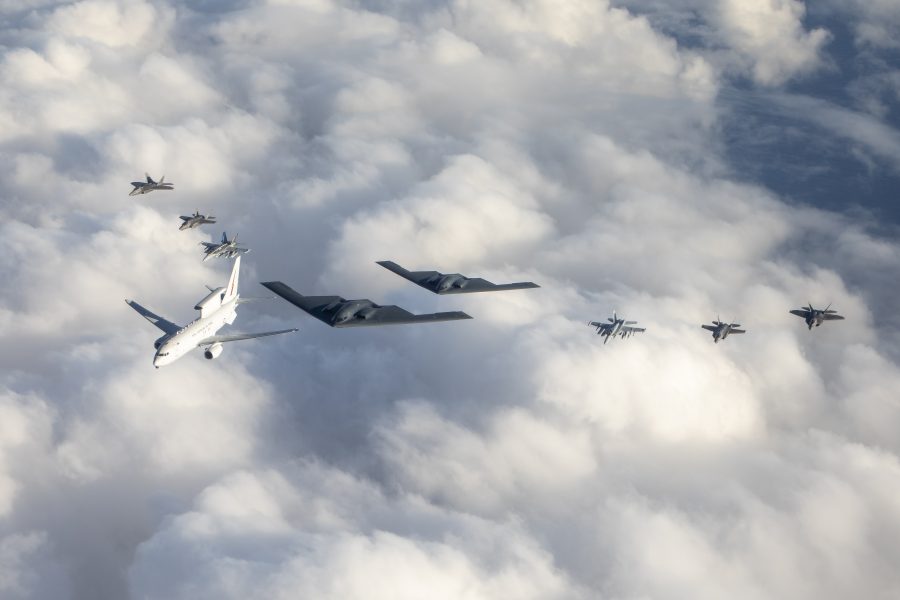Audio of this article is brought to you by the Air & Space Forces Association, honoring and supporting our Airmen, Guardians, and their families. Find out more at afa.org
The three B-2 Spirits that touched down in Australia last week for a Bomber Task Force have been making waves across the Indo-Pacific, with show-stopping formation flight and a rare landing at a strategic location.
Two of the B-2s conducted a flight escorted by American F-22s, two Royal Australian Air Force F-35As, two EA-18G Growlers, and one E-7A Wedgetail throughout the airspace of southeastern Australia on Aug 19—an impressive display of airpower between the two allies featuring some of their most advanced fighter, bomber, electronic warfare, and airborne early warning and control aircraft.
Australian KC-30A tankers later joined the flight to refuel the bombers and the Growlers mid-air.
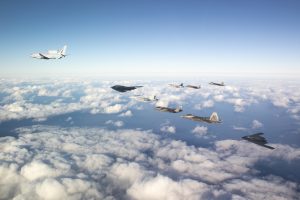
A Royal Australian Air Force E-7A Wedgetail, two EA-18G Growler jets and two F-35A Lightning II jets fly in formation with two United States Air Force B-2 Bombers and two F-22 Raptor fighter jets. *** Local Caption *** A Bomber Task Force consisting of United States Air Force B-2 Spirit stealth bombers, aviators and equipment from the 509th Bomb Wing and 131st Bomb Wing, are operating out of Royal Australian Air Force (RAAF) Base Amberley in Queensland.
This deployment provides an opportunity for Australia and the United States to deepen air-to-air integration as part of the Enhanced Air Cooperation.
RAAF and the United States Air Force have a longstanding shared history of military-to-military ties and regularly train together to improve interoperability. 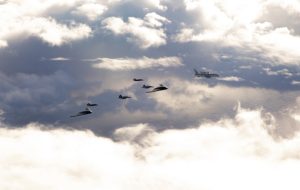
A Royal Australian Air Force E-7A Wedgetail, two EA-18G Growler jets and two F-35A Lightning II jets fly in formation with two United States Air Force B-2 Bombers and two F-22 Raptor fighter jets. *** Local Caption *** A Bomber Task Force consisting of United States Air Force B-2 Spirit stealth bombers, aviators and equipment from the 509th Bomb Wing and 131st Bomb Wing, are operating out of Royal Australian Air Force (RAAF) Base Amberley in Queensland.
This deployment provides an opportunity for Australia and the United States to deepen air-to-air integration as part of the Enhanced Air Cooperation.
RAAF and the United States Air Force have a longstanding shared history of military-to-military ties and regularly train together to improve interoperability.
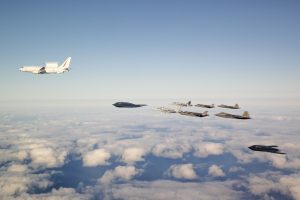
A Royal Australian Air Force E-7A Wedgetail, two EA-18G Growler jets and two F-35A Lightning II jets fly in formation with two United States Air Force B-2 Bombers and two F-22 Raptor fighter jets. (Royal Australian Air Force photo by FSGT Christopher Dickson)
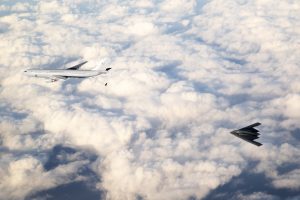
A Royal Australian Air Force KC-30A Multi-role Tanker Transport aircraft prepares to conduct air-to-air refuelling with a United States Air Force B-2 Bomber. *** Local Caption *** A Bomber Task Force consisting of United States Air Force B-2 Spirit stealth bombers, aviators and equipment from the 509th Bomb Wing and 131st Bomb Wing, are operating out of Royal Australian Air Force (RAAF) Base Amberley in Queensland.
This deployment provides an opportunity for Australia and the United States to deepen air-to-air integration as part of the Enhanced Air Cooperation.
RAAF and the United States Air Force have a longstanding shared history of military-to-military ties and regularly train together to improve interoperability.
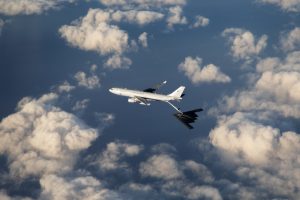
A Royal Australian Air Force KC-30A Multi-role Tanker Transport aircraft prepares to conduct air-to-air refuelling with a United States Air Force B-2 Bomber. *** Local Caption *** A Bomber Task Force consisting of United States Air Force B-2 Spirit stealth bombers, aviators and equipment from the 509th Bomb Wing and 131st Bomb Wing, are operating out of Royal Australian Air Force (RAAF) Base Amberley in Queensland.
This deployment provides an opportunity for Australia and the United States to deepen air-to-air integration as part of the Enhanced Air Cooperation.
RAAF and the United States Air Force have a longstanding shared history of military-to-military ties and regularly train together to improve interoperability.
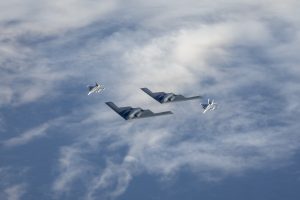
Two Royal Australian Air Force EA-18G Growler jets fly in formation with two United States Air Force B-2 Bomber aircraft. *** Local Caption *** A Bomber Task Force consisting of United States Air Force B-2 Spirit stealth bombers, aviators and equipment from the 509th Bomb Wing and 131st Bomb Wing, are operating out of Royal Australian Air Force (RAAF) Base Amberley in Queensland.
This deployment provides an opportunity for Australia and the United States to deepen air-to-air integration as part of the Enhanced Air Cooperation.
RAAF and the United States Air Force have a longstanding shared history of military-to-military ties and regularly train together to improve interoperability.
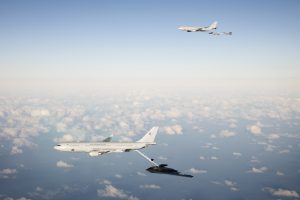
Royal Australian Air Force KC-30A, Multi-role Tanker Transport, aircraft prepare to conduct air-to-air refuelling with a United States Air Force B-2 Bomber and two EA-18G Growler jets. *** Local Caption *** A Bomber Task Force consisting of United States Air Force B-2 Spirit stealth bombers, aviators and equipment from the 509th Bomb Wing and 131st Bomb Wing, are operating out of Royal Australian Air Force (RAAF) Base Amberley in Queensland.
This deployment provides an opportunity for Australia and the United States to deepen air-to-air integration as part of the Enhanced Air Cooperation.
RAAF and the United States Air Force have a longstanding shared history of military-to-military ties and regularly train together to improve interoperability.
Later in the week, one of the B-2s made a quick pit stop at Diego Garcia in the Indian Ocean, located some 3,000 miles from the mainland. Airmen from the 110th Expeditionary Bomb Squadron changed crews while the ground team quickly refueled the bomber and got it airborne again, all with the engines running—a process known as “hot pitting.”
The team has streamlined this process to ensure more efficiency with fewer personnel.
“In the past, our hot pit crews have been a large group, with a big footprint, going out and setting up,” Col. Matthew Howard, 110th EBS deputy commander and B-2 pilot, said in a release. “With more iterations of this process, we’ve been making it leaner under the Agile Combat Employment concept, where we can land a jet with the minimum number of people, turn the jet, and then get it airborne.”
These bomber missions are designed to enhance readiness “to respond to any potential crisis or challenge in the Indo-Pacific” through joint operations, the release added.
“If we lose a tanker or don’t get a tanker for aerial refueling, a hot pit enables us to move our jet from location to location, refuel and complete the mission,” added Howard.
Diego Garcia hosts a Naval Support Facility and provides access to the Indo-Pacific, Southwest Asia, the Middle East, and Africa. It regularly sees USAF bombers fly in, such as in March when two B-52 Stratofortresses landed there. It has been four years, however, since the Air Force has announced a B-2 landing on the island.
The B-2s are currently deployed to RAAF base Amberley, along with two KC-135R tankers from the Illinois National Guard.
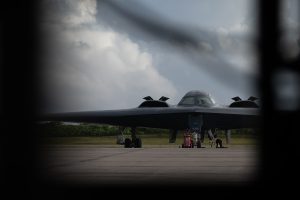
A U.S. Air Force B-2 Spirit is prepared for hot pit refueling for a Bomber Task Force mission at Diego Garcia, British Indian Ocean Territory, Aug. 21, 2024. Hot pit refueling is the act of having an aircraft land, refuel and take off without shutting its engines down. (U.S. Air National Guard photo by Staff Sgt. Whitney Erhart)
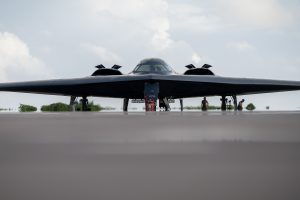
U.S. Air Force Airmen assigned to the 110th Expeditionary Bomb Squadron prepare a B-2 Spirit stealth bomber for hot pit refueling during a Bomber Task Force mission at Diego Garcia, British Indian Ocean Territory, Aug. 21, 2024. Bomber missions enhance the U.S. Air Force’s readiness to respond to any potential crisis or challenge in the Indo-Pacific through joint and multilateral operations. (U.S. Air National Guard photo by Staff Sgt. Whitney Erhart)
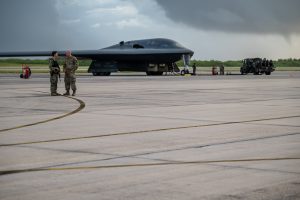
U.S. Air Force Staff Sgt. Nathan Klein, a security forces officer assigned to the 110th Expeditionary Bomb Squadron talks with a U.S. Navy Seaman security forces officer during a Bomber Task Force mission at Diego Garcia, British Indian Ocean Territory, Aug. 21, 2024. Bomber missions contribute to joint force lethality by demonstrating USAF ability to operate anywhere in the world at any time in support of the National Defense Strategy. (U.S. Air National Guard photo by Staff Sgt. Whitney Erhart)
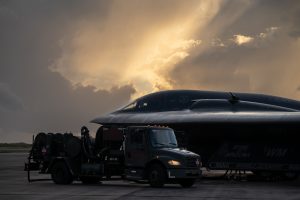
A U.S. Air Force B-2 Spirit is hot pit refueled during a Bomber Task Force mission at Diego Garcia, British Indian Ocean Territory, Aug. 21, 2024. Hot pit refueling is the act of having an aircraft land, refuel and take off without shutting its engines down. (U.S. Air National Guard photo by Staff Sgt. Whitney Erhart)
Earlier this month, the Air Force also deployed F-22s from the 27th Expeditionary Fighter Squadron to Australia. The Raptors, along with the RAAF’s F-35s, conducted a joint hot pit refuel mission at the nation’s western base, Curtin. The strategically located base is still undergoing development, as it prepares to host more temporary operations.
“We’re willing to take risks if it means better agility and combat capability,” Master Sgt. Luke Ashman, 27th Expeditionary Fighter Generation Squadron aircraft section chief, said in a release. “The execution of this went very smoothly, the RAAF seems to operate on the same wavelength as us.”
These bomber and fighter operations with Australian forces follow the U.S.-Australian ministerial conference earlier this month, where the two countries’ defense chiefs said they would increase the presence of U.S. aircraft in Australia.
“We’re increasing the presence of rotational U.S. forces in Australia” Defense Secretary Lloyd J. Austin said at the time, to include “more maritime patrol aircraft and reconnaissance aircraft operating from bases across northern Australia.” He added that the allies are planning on “more frequent rotational bomber deployments.”
Audio of this article is brought to you by the Air & Space Forces Association, honoring and supporting our Airmen, Guardians, and their families. Find out more at afa.org
